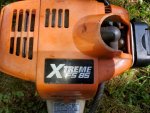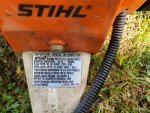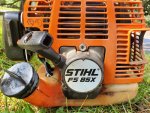TerraForte
Member
- Joined
- Jun 17, 2019
- Threads
- 7
- Messages
- 33
TL R;
R;
Running issues with FS85X
Current main issue is that it hangs down load. Lean out L mix screw, idle falls until it's about to stall, but if I enrichen the L mix screw, it revs up again. Seems to be no happy medium.
Backstory:
Last year I saw a used Stihl FS85X on craigslist.

XXXXXtreme!
Fun fact: After MUCH searching I eventually determined that "FS85X" turns up zero results. It's actually an "FS85 RX". R meaning loop handle, and the X means it's the "lightweight version" with the low-interia hollow-center shaft. Shaves 0.5lbs off, while revving higher, but the trade-off is you cannot use the gearbox attachments with the hollow shaft.
It was $60, delivered!
Started easily, idled well, ran perfect.
I used it probably ~2 hours in total. No issues. Very lightweight and revved quite fast compared to my other trimmers (must be that XXXtreme thing). Surprised it's a 25.4cc.

I stopped using it because I felt it was too peak-y and preferred my Echo 266.
I went to use it 2-3 weeks later, and it wouldn't run, at all.
It was stored in a damp garage w/tendency to flood. Most stuff developed spiderweb-like mildew on bottom 6in, this trimmer included.
This season I worked on it.
Cleaned up mildew and dried oil gunk on lower case.
New fuel (tank and purged carb).
Visually inspected the cylinder. Looked great.
Started and idled--- did not tinker with carb.
Re-visit, and it'll cough over once or twice but won't run.
Took carb apart thinking float was to blame.
Idles, but it will not rev.
I re-set L/H mix screws.
All the way CW, and then follow markings on the shroud.

It will not run at the suggested 1 turn CCW for L, and 3/4 turn CCW for H.
I do my own thing to get it tuned down low, and I eventually get it to idle for long periods of time.
I check spark plug and coil gap. Both needed adjustment.
I adjusted the high mix until it revved well and used it for 10mins, 80% of time at full throttle while cutting grass with the string fully extended.
I tried to adjust the H screw while in use. I would wind it up, and hear it missing very slightly at max speed, so I enriched the H mix. Not sure if this is correct.
I couldn't get the d-d-d-d-d-w-w-w-wah-wah-wah-WAH-WAHHH-WAHHHH-WAHHHHHHHHH out of it though like in some carb adjust videos.
Then I realized it won't 'settle' down. The idle screw wasn't touching, so it must be too rich down low.
If I lean out the mix, it doesn't respond for ~1/4 turn, then it settles down. I stop. Then it starts to die. I enrichen it the smallest increment I can, and then it's "hanging" again, idling too high.
I've tried 'dancing' with it so many times, I'm convinced there's an internal carb issue such as a broken diaphragm or etc.
Running issues with FS85X
Current main issue is that it hangs down load. Lean out L mix screw, idle falls until it's about to stall, but if I enrichen the L mix screw, it revs up again. Seems to be no happy medium.
Backstory:
Last year I saw a used Stihl FS85X on craigslist.

XXXXXtreme!
Fun fact: After MUCH searching I eventually determined that "FS85X" turns up zero results. It's actually an "FS85 RX". R meaning loop handle, and the X means it's the "lightweight version" with the low-interia hollow-center shaft. Shaves 0.5lbs off, while revving higher, but the trade-off is you cannot use the gearbox attachments with the hollow shaft.
It was $60, delivered!
Started easily, idled well, ran perfect.
I used it probably ~2 hours in total. No issues. Very lightweight and revved quite fast compared to my other trimmers (must be that XXXtreme thing). Surprised it's a 25.4cc.

I stopped using it because I felt it was too peak-y and preferred my Echo 266.
I went to use it 2-3 weeks later, and it wouldn't run, at all.
It was stored in a damp garage w/tendency to flood. Most stuff developed spiderweb-like mildew on bottom 6in, this trimmer included.
This season I worked on it.
Cleaned up mildew and dried oil gunk on lower case.
New fuel (tank and purged carb).
Visually inspected the cylinder. Looked great.
Started and idled--- did not tinker with carb.
Re-visit, and it'll cough over once or twice but won't run.
Took carb apart thinking float was to blame.
Idles, but it will not rev.
I re-set L/H mix screws.
All the way CW, and then follow markings on the shroud.

It will not run at the suggested 1 turn CCW for L, and 3/4 turn CCW for H.
I do my own thing to get it tuned down low, and I eventually get it to idle for long periods of time.
I check spark plug and coil gap. Both needed adjustment.
I adjusted the high mix until it revved well and used it for 10mins, 80% of time at full throttle while cutting grass with the string fully extended.
I tried to adjust the H screw while in use. I would wind it up, and hear it missing very slightly at max speed, so I enriched the H mix. Not sure if this is correct.
I couldn't get the d-d-d-d-d-w-w-w-wah-wah-wah-WAH-WAHHH-WAHHHH-WAHHHHHHHHH out of it though like in some carb adjust videos.
Then I realized it won't 'settle' down. The idle screw wasn't touching, so it must be too rich down low.
If I lean out the mix, it doesn't respond for ~1/4 turn, then it settles down. I stop. Then it starts to die. I enrichen it the smallest increment I can, and then it's "hanging" again, idling too high.
I've tried 'dancing' with it so many times, I'm convinced there's an internal carb issue such as a broken diaphragm or etc.
